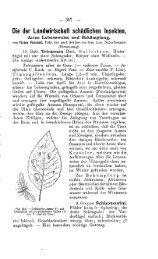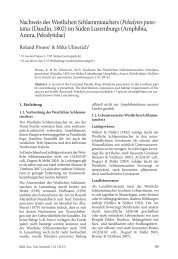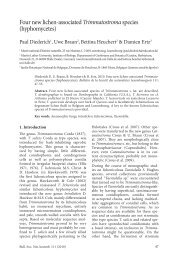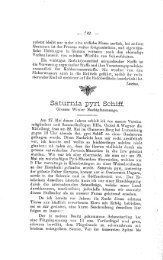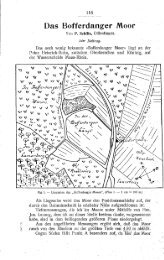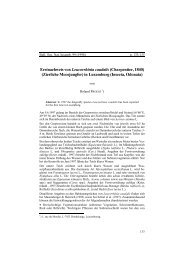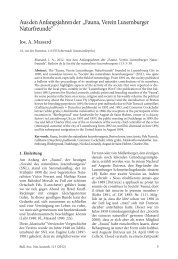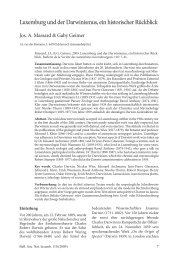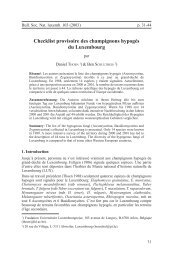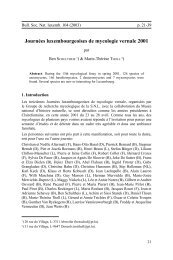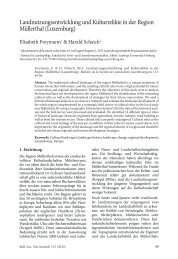New or interesting lichens and lichenicolous fungi from Bel ... - SNL
New or interesting lichens and lichenicolous fungi from Bel ... - SNL
New or interesting lichens and lichenicolous fungi from Bel ... - SNL
You also want an ePaper? Increase the reach of your titles
YUMPU automatically turns print PDFs into web optimized ePapers that Google loves.
2. Survey of other publications on the<br />
lichen fl<strong>or</strong>a <strong>and</strong> vegetation of the study<br />
area<br />
Boulanger et al. (2009) published a rep<strong>or</strong>t<br />
<strong>from</strong> a lichenological excursion done in<br />
the Boulonnais (France, Pas-de-Calais)<br />
in 2008. Several species not previously<br />
accepted in the checklist were mentioned.<br />
In a supplement to this first paper,<br />
Boulanger et al. (2010) gave additional<br />
inf<strong>or</strong>mation on some rare <strong>or</strong> problematic<br />
taxa. Arthonia varians (Ach.) Nyl.,<br />
a species usually growing on the saxicolous<br />
Lecan<strong>or</strong>a rupicola (incl. L. bicincta)<br />
(Grube 2007), although rep<strong>or</strong>ted <strong>from</strong><br />
other hosts, such as L. actophila (Clauzade<br />
et al. 1989) <strong>and</strong> L. helicopis (Wahlenb.)<br />
Ach. (Ihlen & Wedin 2008), is rep<strong>or</strong>ted<br />
<strong>from</strong> Lecan<strong>or</strong>a helicopis (Boulanger et al.<br />
2010) <strong>and</strong> is new to the checklist area. The<br />
host, Lecan<strong>or</strong>a helicopis, is as well new<br />
to the checklist area. Diplotomma glaucoatrum<br />
(Nyl.) is a non-validly published<br />
new combination of Buellia glaucoatra<br />
(Nyl.) Clauzade; this species is considered<br />
as a synonym of D. alboatrum (Hoffm.)<br />
Flot. by N<strong>or</strong>din (2000), but as a distinct<br />
species by Roux (pers. comm.), distinguished<br />
by a thicker thallus <strong>and</strong> the occurrence<br />
on coastal rocks; Boulanger et al.<br />
(2009, 2010) state that the species has been<br />
observed in 1989 near cap Griz-Nez, but<br />
in the absence of any reference specimens<br />
it is wise to consider this rep<strong>or</strong>t as doubtful.<br />
The rep<strong>or</strong>t by Boulanger et al. (2009)<br />
of Lecania aipospila (Wahlenb.) Th.Fr. is<br />
not supp<strong>or</strong>ted by any herbarium specimen<br />
<strong>and</strong> theref<strong>or</strong>e has to be removed <strong>from</strong> the<br />
checklist (Boulanger et al. 2010); a previous<br />
Boulonnais rec<strong>or</strong>d of this species (Van<br />
den Broeck et al. 2009) proved to represent<br />
L. cf. fructigena (Diederich et al. 2009).<br />
Boulanger et al. (2009: 175, 181) doubtfully<br />
rep<strong>or</strong>ted Lecan<strong>or</strong>a ripartii Lamy<br />
(they hesitated between L. ripartii <strong>and</strong> L.<br />
atrynea, the latter being a m<strong>or</strong>photype<br />
of L. cenisia), illustrated by a photograph<br />
done near cap Griz-Nez; later, Boulanger<br />
et al. (2010) stated that this was a misidentification<br />
f<strong>or</strong> L. campestris (Schaer.) Hue.<br />
Opegrapha trifurcata Hepp, keyed out by<br />
Clauzade & Roux (1985), might be identi-<br />
cal to the Boulonnais material published<br />
by Sparrius et al. (2002) as Opegrapha saxatilis<br />
DC. s.l.; a m<strong>or</strong>e detailed study of this<br />
group is urgently needed; following Roux<br />
(pers. comm.), the type of O. saxatilis<br />
[kept in G] belongs to the <strong>lichenicolous</strong> O.<br />
rupestris Pers., whilst the type of O. trifurcata<br />
is a species closely related to Arthonia<br />
atra (Pers.) A.Schneid. Xanth<strong>or</strong>ia aureola<br />
(Ach.) Erichsen has never been c<strong>or</strong>rectly<br />
rep<strong>or</strong>ted <strong>from</strong> the Boulonnais; the recent<br />
rep<strong>or</strong>t by Van den Broeck et al. (2009)<br />
proved to be m<strong>or</strong>e strongly pigmented X.<br />
parietina; the rep<strong>or</strong>t by Boulanger et al.<br />
(2009) is unf<strong>or</strong>tunately not sustained by<br />
any herbarium specimen (Boulanger pers.<br />
comm.), all specimens collected belonging<br />
to X. calcicola <strong>or</strong> X. parietina (Boulanger<br />
et al. 2010).<br />
Hellemans & Stappaerts (2009) discovered<br />
Stereocaulon pileatum on a brick wall as new<br />
to Fl<strong>and</strong>ers.<br />
Van den Broeck et al. (2009) presented the<br />
rep<strong>or</strong>t <strong>from</strong> a lichenological excursion done<br />
in 2008 near De Panne (<strong>Bel</strong>gium, Mar. <strong>and</strong><br />
Brab.). Many species are new rec<strong>or</strong>ds f<strong>or</strong><br />
Fl<strong>and</strong>ers <strong>or</strong> f<strong>or</strong> the Maritime <strong>or</strong> Brabant<br />
phytogeographical districts. Further rep<strong>or</strong>ts<br />
<strong>from</strong> excursions in Fl<strong>and</strong>ers refer to the surrounding<br />
of Mol (Van den Broeck 2009a),<br />
Balen <strong>and</strong> Meerhout (Van den Broeck<br />
2009b), Tongerlo (Van den Broeck & Hellemans<br />
2009) <strong>and</strong> Serskamp (Stieperaere &<br />
Van den Broeck 2009).<br />
Bertr<strong>and</strong> et al. (2010) present a remarkable<br />
revision of the po<strong>or</strong>ly known Lecan<strong>or</strong>a<br />
b<strong>and</strong>olensis B. de Lesd. This species belongs<br />
to the L. dispersa group <strong>and</strong> is confined to<br />
coastal rocks. The auth<strong>or</strong>s have studied a<br />
specimen <strong>from</strong> our study area, collected in<br />
1989 near Cap Gris-Nez by C. Van Haluwyn.<br />
We have examined an additional<br />
specimen (France, Mar., Pas-de-Calais,<br />
entre Ambleteuse et Wimereux, rochers au<br />
b<strong>or</strong>d de la mer à 600 m au N de la Pointe<br />
aux Oies, E22.35, alt. 5 m, rochers de grès<br />
émergés en permanence, 2000, P. Diederich<br />
14444, h).<br />
Sérusiaux et al. (2010) rep<strong>or</strong>t the discovery<br />
of Biat<strong>or</strong>a ligni-mollis T. Sprib. & Printzen<br />
<strong>from</strong> <strong>Bel</strong>gium (Ard.), where it was collected<br />
on an old Quercus in the f<strong>or</strong>êt d’Anlier.<br />
34 Bull. Soc. Nat. luxemb. 111 (2010)



